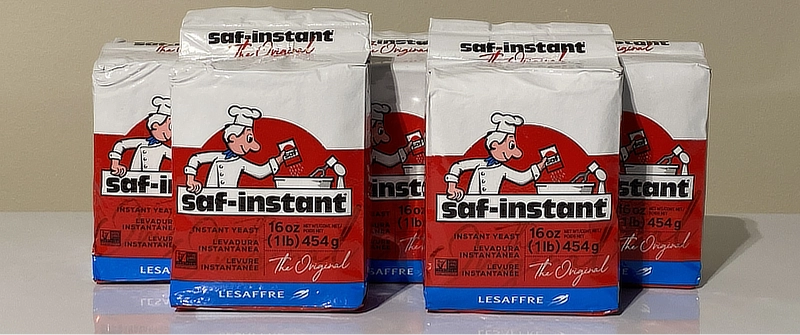How Much Instant Dry Yeast To Go With One’s Wheat Storage
Have you thought about this? You have purchased and set aside an amount of wheat (wheat berries) for preparedness. Buckets or pails sealed for decades-long storage, just in case. Wheat can store perfectly well for many decades and will always be ready to make bread whenever you like. But do you have enough of the other ingredients (such as instant dry yeast) to coincide with the amount of wheat that you have stored? Well here’s how to figure it out…
First, just a reminder. From a preparedness point of view, wheat storage (actually, ‘wheat berries’ before milling into flour), is one of many excellent choices for long-term food storage. One five-gallon bucket of wheat has approximately 45,000 calories and will provide the main ingredient to make about 25 loaves of bread. Don’t forget that you will also need a grain mill.
Okay, back to the issue at hand. How much yeast is needed to go along with one’s wheat storage to eventually make loaves of bread?
I know what some of you might be thinking right now… You could make sourdough bread with naturally occurring yeast. Or you could use the milled wheat flour to make tortillas (no yeast required). Yes, both of these methods are ways to use and consume your stored wheat without having any yeast. But let’s go through the brief exercise anyway…
How Much Instant Dry Yeast To Make Bread
Before we can figure out how much instant dry yeast is needed to go along with the stored wheat or wheat berries, we will need to know how much instant dry yeast is needed to make a loaf of bread.
I personally use instant dry yeast rather than active dry yeast.
Instant dry yeast can be mixed directly into dry ingredients, whereas active dry yeast has a larger granule and needs to be dissolved in water before use.
Instant yeast is manufactured to be more stable and can be added directly to the dough without any additional hydration. This makes it a convenient option for bakers who want to skip the extra step of dissolving the yeast in water.
Instant yeast is also more potent than active dry yeast, which means you may need to use less of it to achieve the same results.
The exact amount of yeast depends on factors such as the recipe/size of the bread loaf (amount of flour), the type of yeast (usually instant dry yeast), and the desired rising time (to double in size).
Here’s a guideline.
| Cups of Flour in Bread Loaf | Teaspoons of Instant Dry Yeast for Rise |
| 2 Cups | ½ – 1 tsp |
| 3 Cups | ¾ – 1¼ tsp |
| 4 Cups | 1 – 2½ tsp |
The yeast will enable the flour/dough mixture to rise and double in size. Using more yeast will speed up the rise time. Using less yeast will require a longer time before it has doubled in size. It’s not so much about the exact quantity of yeast, rather, it’s about the approx. doubling in size – somewhat regardless of how long it takes to do that.
So the guideline listed above is just that. A guideline. Recipes differ to an extent. However, the guideline will enable us to determine the total quantity of yeast to store along with all of your stored wheat/wheat berries.

A typical loaf of bread with 3 cups of flour will require up to 1¼ teaspoons of instant dry yeast.
If you make your bread using 3 cups of flour (which is typical), you might use up to 1¼ teaspoons of instant dry yeast for the rise.
One pound of instant dry yeast will be enough for about 115 loaves of bread.
I did the math. One pound of Instant Dry Yeast (such as saf-instant or Fleischmann’s) is equivalent to 144 teaspoons. So if you use 1¼ teaspoons of instant dry yeast per loaf of bread, one pound of instant dry yeast will yield about 115 loaves.
Okay, we’re getting there. Now we know how much yeast is needed to make a loaf of bread and we know how many loaves of bread a pound of yeast will make. Now let’s use that information to figure out how much yeast to go with ‘x’ pounds of flour or wheat.
I did the math. There are approximately 18 cups of flour in a 5-pound bag (varies slightly depending on density). This will make about 6 loaves of bread. That’s about 8 teaspoons of instant dry yeast needed per 5-pound bag of flour/wheat.
Let’s say it another way. For every 10 pounds of flour or wheat, you may need about 16 teaspoons of instant dry yeast to make bread. So if you have stored 100 pounds of wheat berries for the sake of preparedness, you would need about 160 teaspoons of yeast, or a little more than 1-pound of instant dry yeast to go with it.
To keep it simple, let’s just say the following:
For every 100 pounds of stored wheat/wheat berries, you may need 1 pound of instant dry yeast to make bread.
After your calculations, just get an additional pound, just in case (it’s not expensive).

I’m sure that it is not uncommon for serious preppers to have hundreds of pounds of wheat berries stored for the long term. Wheat berries vacuum-sealed in a Mylar bag filling a 5-gallon pail/bucket will last for many decades and weigh about 30 – 33 pounds (in my experience).
There are roughly 45,000 calories in a 5-gallon pail of wheat berries. In other words, about 22 survival days. To accommodate a year of survival, that would be approximately 16 (5-gallon) pails, or about 500 pounds of wheat berries. This would require five 1-pound packets of instant dry yeast if you were to use all of it for breadmaking.
By the way, most sources indicate that instant dry yeast can be stored in the freezer for a longer shelf life. Personally, I keep mine vacuum-sealed and stored in a cool, dry place. I’ve used yeast many years later without issue. However once opened, keep it in the fridge, dry and sealed.
Yeast Jar par excellence
(view on amzn)

“I bought this jar to hold a pound of yeast that I keep in my freezer. It is the perfect container. It seals beautifully to keep moisture out, is see-through so I can see at a glance how much I have left, and is very well made.”
Comment review on amzn
Lastly, I certainly do not recommend surviving on wheat/flour/bread alone! Rice and Beans store perfectly well too. Work on a well-diversified portfolio of food storage. Grocery-store canned foods too (just try to consume it within 2 years and rotate). Don’t forget the protein. Learn home canning. Utilize a chest freezer for vacuum-sealed meat. On and on…
[ Read: Choosing A Hand Grain Mill ]
[ Read: How Many Pounds of Flour or Wheat to Make Loaves of Bread ]

